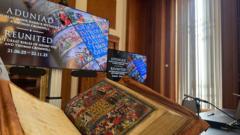What Happens When Great Bibles Are Reunited After 500 Years?

Unveiling the Great Bibles of Henry VIII and Thomas Cromwell: A Journey Through History
In a remarkable turn of events, two unique copies of the Great Bibles, commissioned by Henry VIII and Thomas Cromwell, have been reunited for the first time in nearly 500 years. These exquisite editions from 1538-39 were printed on parchment and hand-coloured by some of Europe's finest artists. As the first authorized English edition of the Bible, their significance is monumental, not just for historical scholarship but also for their profound impact on religious reform in England and Wales. This article delves into the history behind these Bibles, their artistic intricacies, and the groundbreaking research techniques that have revealed new insights into their creation and modification.
The Historical Significance of the Great Bibles
The Great Bibles, commissioned during a time of profound religious upheaval in England, represent a significant milestone in the history of the English Bible. Under the reign of Henry VIII, the desire for a Bible available in the vernacular, a language that the common people could understand, became a vital component of religious reform. Thomas Cromwell, as the King’s chief minister, played an instrumental role in this transition, promoting the translation and dissemination of the Bible throughout the realm.
Upon Henry VIII's order, these Bibles were intended to be distributed to every parish in England and Wales, ensuring that the scriptures were accessible to all. This monumental shift not only altered the religious landscape but also catalyzed the translation of the Bible into Welsh, culminating in the creation of William Morgan's Bible in 1588. Without the Great Bible, the Welsh language might not have flourished as it has today.
The Reunion of Two Unique Copies
For a limited time, the National Library of Wales in Aberystwyth, Ceredigion, is hosting an exhibition showcasing these two remarkable copies of the Great Bible. Curator Maredudd ap Huw describes the event as "a once-in-a-lifetime opportunity," emphasizing that these two Bibles will not be brought together again for a long while. This exhibition provides an unparalleled chance to witness two milestones in Tudor history, allowing visitors to appreciate the cultural and religious implications of these monumental texts.
The Artistic Excellence Behind the Great Bibles
What sets these copies of the Great Bible apart is not just their textual significance but also their artistic craftsmanship. Printed on high-quality parchment and embellished with intricate hand-coloured illustrations, they embody the artistic spirit of the Renaissance. The illustrations within the Bibles were not merely decorative; they served to enhance understanding and engagement with the text. Through the use of vibrant pigments and elaborate designs, artists sought to convey theological themes and narratives in visually compelling ways.
In recent years, cutting-edge technologies have allowed researchers to examine these illustrations in greater detail than ever before. The Hidden in Plain Sight project employs advanced tools ranging from 3D microscopy to DNA analysis, uncovering layers of modifications made to the illustrations throughout the centuries. These discoveries are not just fascinating; they provide critical insights into the sociopolitical contexts of the time.
Technological Insights: Uncovering the Bibles' Secrets
The integration of modern technology into the study of historical texts has transformed our understanding of how these Bibles were created and altered over time. Dr. Harry Spillane, a researcher involved in the Hidden in Plain Sight project, notes that while these Bibles have existed for 500 years, new technologies are unveiling changes that were previously hidden. This includes the discovery of layers of paper and multiple glued-on designs that were used to perfect the illustrations.
One particularly intriguing revelation is the deliberate manipulation of certain images within the Bibles. For instance, the portrait of Thomas Cromwell was painted and pasted into the title page of one of the copies, a detail that had remained expertly concealed for centuries. Additionally, alterations made to an image of a courtly woman were undertaken to resemble Jane Seymour, Henry VIII's beloved consort who had recently passed away. Such modifications highlight the lengths to which supporters of reform, like Cromwell, would go to garner royal support.
Analyzing the Artistic Contributions
Dr. Suzanne Paul from Cambridge University Library emphasizes the importance of the technological analyses being conducted on these Bibles. She describes it as an exploration of "the archaeology of the bibles," which allows specialists to identify particular workshops responsible for the artistic work. By analyzing the various pigments used in the illustrations and comparing them to other artworks from the same period, researchers are piecing together the geographical and artistic origins of these Bibles.
Although the artists may not have left physical signatures on the Bibles, their unique chemical signatures embedded in the pigments provide a new avenue for historical research. This merging of art and science is paving the way for a deeper understanding of the cultural and political dynamics at play during the Tudor period.
The Impact of the Great Bible on Language and Culture
The Great Bible's distribution marked a turning point in the relationship between language, religion, and national identity. By providing the Bible in English, it enabled ordinary citizens to engage directly with the scriptures, fostering a more personal relationship with faith. This democratization of religious texts contributed to the rise of literacy and the eventual establishment of the English language as a dominant form of communication in the realm.
Furthermore, the translation of the Bible into Welsh was a direct consequence of the Great Bible's influence. The subsequent creation of William Morgan's Bible in 1588 ensured that Welsh speakers could access the scriptures in their native tongue, preserving the language and its cultural heritage. The legacy of the Great Bible is thus interwoven with the very fabric of Welsh identity.
Conclusion: A Lasting Legacy
The reunion of the Great Bibles of Henry VIII and Thomas Cromwell offers a unique glimpse into a pivotal moment in history. Their presence at the National Library of Wales serves as a reminder of the profound changes that occurred during the Tudor period and the lasting impact these texts have had on language, culture, and religious practice. The ongoing research into these Bibles continues to reveal more about their creation and modification, inviting us to reflect on the complexities of faith, art, and politics throughout history.
As we marvel at the intricate craftsmanship and the historical significance of these Bibles, we are reminded of the power of written words to shape societies and cultures. What other hidden stories might ancient texts hold, waiting to be discovered through advancements in technology and scholarship?
FAQs about the Great Bibles of Henry VIII and Thomas Cromwell
What is the Great Bible, and why was it significant?
The Great Bible is the first authorized English edition of the Bible, commissioned by Henry VIII and supported by Thomas Cromwell. Its significance lies in making the scriptures accessible to the common people, fostering religious reform and literacy in England and Wales.
Where can I see the reunited Great Bibles?
The Great Bibles are on display at the National Library of Wales in Aberystwyth, Ceredigion, as part of a special exhibition that runs until November 22. This is a rare opportunity to see these historical artifacts side by side.
What technologies are being used to study the Bibles?
Modern technologies such as 3D microscopy and DNA analysis are being employed to uncover hidden details and modifications within the Bibles. These advancements allow researchers to explore the artistic techniques and historical contexts that shaped these texts.
The reunion of these Great Bibles serves not only as a historical occasion but also as an invitation to reflect on the power of words and images in shaping our understanding of faith and identity. What stories do you think remain hidden in our historical texts, waiting to be uncovered? #GreatBible #TudorHistory #CulturalHeritage
Published: 2025-06-25 11:45:10 | Category: wales



